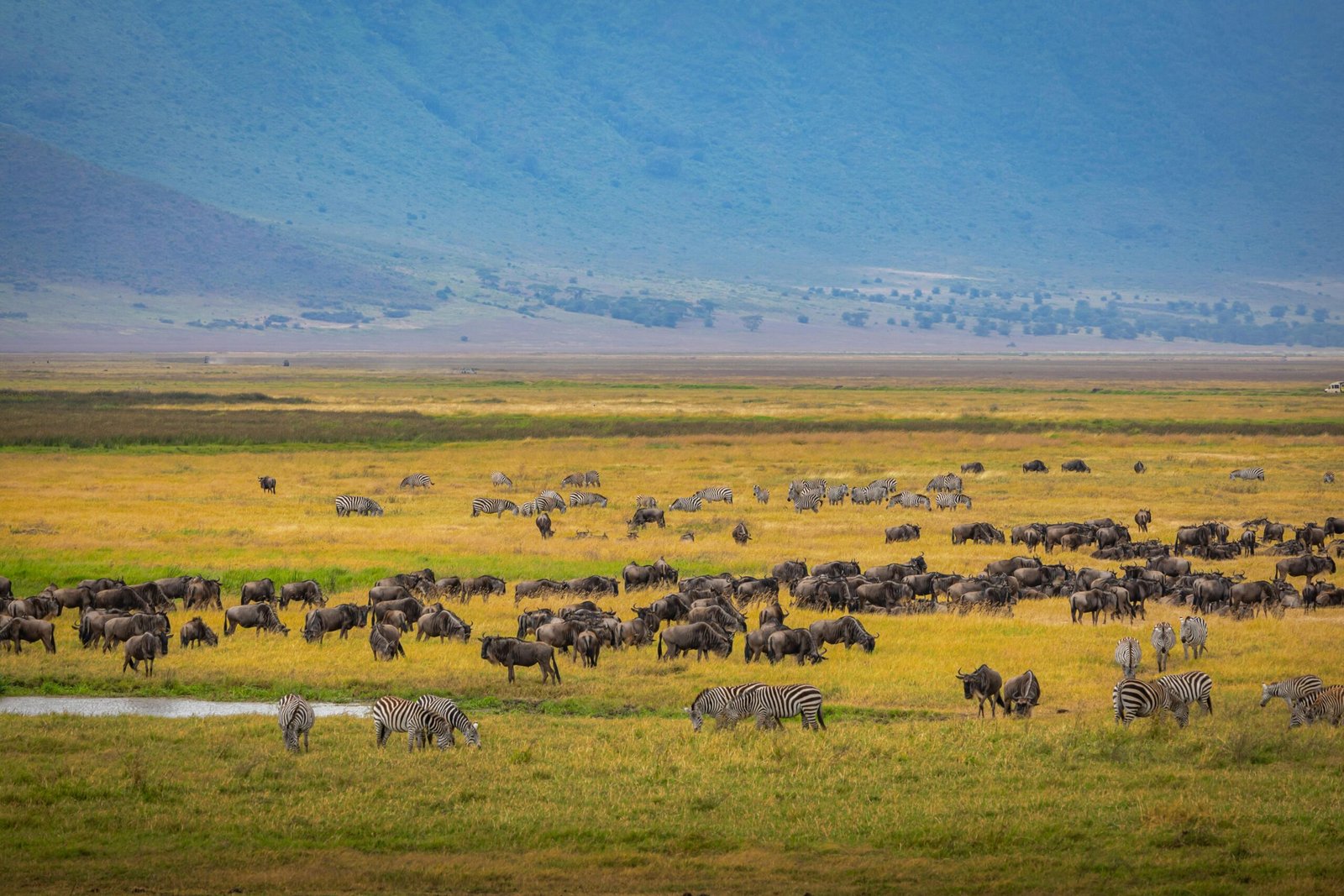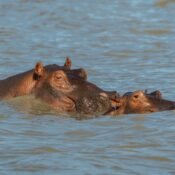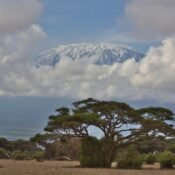
Witness the Circle of Life: Seasonal Safaris in Tanzania & Kenya
One can hardly find anything in this world that can be compared to an East African safari in the aspect of capturing into the rhythm of nature. Every year, the great circle of life takes place in Tanzania and Kenya on big savannas and glittering plains – an ancient dance of survival, migration and regeneration. These seasonal safaris are not any wildlife tourism, and it is the best seats to observe the most remarkable natural drama on the world, which acts in the sky of gold and without any boundaries.
The Great Migration: The biggest spectacle.
Wildebeest of over 1.5 million that include zebras and gazelles cross the Serengeti in Tanzania and the Masai Mara in Kenya each year in an epic manner. One of the most spectacular events in the world is the Great Migration, a great image of the eternal process of life and death on the planet.
The calving season is bestowed on fertile plains in the Southern Serengeti between January and March where the herd beams up. Children are now being born in thousands and the first steps are taken by their alert mothers. Nevertheless, there are never safe here and lions, hyenas, and cheetahs lurk around leaving some unbelievable experiences and memories and showing the naked cruelty of nature.
The herds begin to move northwards at the onset of the dry season and as per the ancient instinct they begin to move towards the Grumeti River and finally towards the Mara River it is where the greatest scenes of the migration happen. The fact that wildebeests plunge into the waters where crocodiles live as they find a way to safety in the panic of a stampede to the Masai wildebeests in Kenya is heart stopping and awe-inspiring. It is a life lesson that gives a reality check of the balance of nature as all its dangers are sustenance to the continuation of life.
Tanzania: Seasons: A Symphony of Change.
The national parks in Tanzania including Serengeti, Ngorongoro Crater, Tarangire, and Lake Manyara have different experiences to present to the visitors based on the seasons.
During the month of January through to March (Calving Season):
The Southern Serengeti is transformed into a nursery. The plains become green and abound with life since nearly half a million calves are born. The predators thrive and the photographers have a good time shooting heart-warming family photos of the dramatic hunts.
April – June (Migration North):
As the rains reduce, the herds drift to the central and western parts of Serengeti. It is the season with less tourists and equally beautiful scenery and the river crossing are dramatic in the Grumeti and Mbalageti rivers.
July – October (Dry Season):
At the very best, the Serengeti is in the north. It is during this period that the great Migration is in its peak with thrilling crossings into Kenya. This is also the most appropriate time to conduct the hot air balloon safaris that offer the panoramic views of the migrating herds.
November -December (Short Rains):
The landscape turns igneous green again. The giraffes and elephants are free to roam as well as the bird watchers can observe the migrant species of Europe and Asia returning to Africa.
Cabin Crew Magazine- Kenya: Season Highlights.
Kenya Masai Mara on the other side of the border imitates the rhythm of the Serengeti and adds its own attractions into it because of the different landscape and the Maasai culture.
July- October (Migration Season):
It is the time the person gets to Kenya, when the herds are there, when the plains are vacant, and alive. Thousands of wildebeests stamping in the valley of the Mara River – thousands of feet and heartbeats. Lions stalk the tall grass and the elephants and buffalo drink the same water holes.
November February (Green):
The sceneries are green following a rain. It is oriented towards the photographers and the travelers who seek more peaceful safaris. The north has been continuous with the calving process and birds inhabit the wetlands of Amboseli and Lake Nakuru.
March to June (Long Rains):
It is also not crowded, and the time is perfect in a case when the traveler wants to be quiet. The flowers in Kenya turn into a live green heaven and hotel and tours are cheaper and this makes it a secret season when the individual is no longer afraid of a shower.
A Visit to the Circle of Life.
A Tanzanian and Kenya safari during a season is not just a hunt game, but it is a lesson of learning to understand the oneness of nature. You will possess the rhythm that is predator, prey, drought and rain, birth and survival.
Predator Action: both Lions of the Serengeti and leopards of the Mara can be interesting to view at any time of the year. They react differently to different plots within different seasons depending on the movement of the prey.
Bird Migrations: These have over 500 species of migrating birds that make the skies colorful to look at. Flamingos and eagles on the Rift valley on Lake Nakuru will provide beauty to the Big Five.
Local Culture: It will be possible to make the visit more human by visiting the Maasai and Hadzabe tribes. The high regard to the nature and traditional living styles highlights the bi-dimensional association of man and wild over the long period.
New Safari Fashion Every Season.
Each season is another adventure:
Luxury Lodges and Mobile Camps: Spend time in ecologically friendly camps, which follow the migration, as a result, be in the center of the process.
Walking and Balloon Safaris: Leave the jeep and see the land either on air or by walking, with the professional guides.
Family and Photography Safaris: Tailor-made programs are provided to the families and the photographers who wish to have the close experience and their own speed.
The Conservation and Responsible Travel.
The seasonal safaris make us remember that these wild areas are not powerful. The conservation programs in Tanzania and Kenya such as the anti-poaching patrols or the community-based tourism has ensured that the future generations will also be able to experience this great cycle. The choice of responsible operators is such a sort of measure to save the wildlife and the local communities.
Every tourist plays a part in the sustenance of such a balance: by following the regulations in the park, by using the services of eco- lodges, by engaging the locals in cultural encounters.
The safari adventures: how to plan effectively.
Timing is everything. You need to go there between the months of July and September in order to get the attainment of the Great Migration crossings. January, in March would be the optimum time to go, the landscapes are also abundant and the wild animals are being born. Greenery and lighting during the months of April and November are the best months that photographers prefer most and the backdrops are beautiful.
Tanzania and Kenya ought to be placed within the same itinerary and leave the migration to follow its course and expose itself to all its stages including calving in the Serengeti and crossing the Mara River. With old hands on the helm and the lodges chosen you will have a easy cruise to one of the last of the great wildernesses on the planet.
Final Thoughts
The changes of the weather in Tanzania and Kenya are not just variations of seasons, it is a part of the eternal play. Every sunrise above the savanna, every thunderstorm above the plains, every wildebeest, born and dead, all of this is a part of the circle of life which is what makes this magical area what it is.
To witness nature in its glory, with all its power and unmanageability and its immense beauty is a sight to witness. The first time traveler and the seasoned traveler can not doubt that he has more than adventure in a seasonal safari in East Africa, but that he has been in touch with the pulse of the planet.




